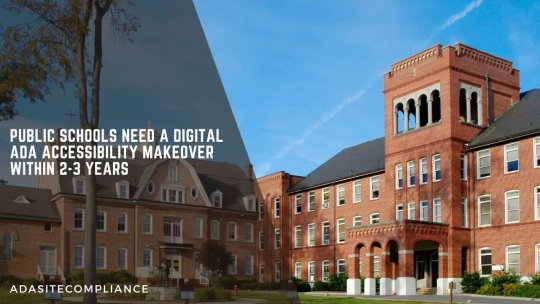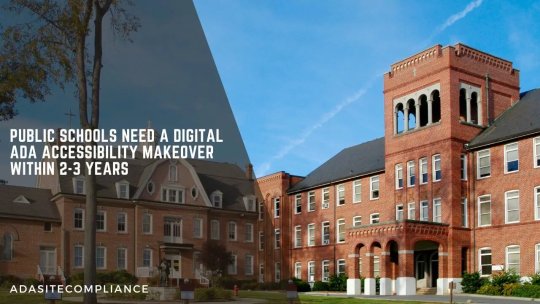#ada compliance deadline 2027
Explore tagged Tumblr posts
Text

Inclusive Digital Experience
ADA Site Compliance creates an inclusive digital experience for schools, ensuring all students can engage with educational content regardless of their abilities!
#ada compliance for schools#digital accessibility in education#u.s. department of justice#ada title ii#world wide web consortium (w3c)#technical accessibility standards#accessibility features#accessible digital content#accessibility consultants#digital content creation#ada title ii 504 compliance#wcag 2.1 standards#ada compliance deadline 2027#universal design in education#school website#inclusive digital experience#assistive technologies#accessible digital content creation#website accessibility solutions#ADA site compliance#ADASiteCompliance#adasitecompliance.com
0 notes
Text
U.S. Department Of Justice

Public Schools Need A Digital ADA Accessibility Makeover Within 2-3 Years
According to a new federal mandate from the U.S. Department of Justice, public schools must make all digital content accessible to students with disabilities.
The U.S. Department of Justice has issued under Title II of the ADA that stipulates compliance with the Web Content Accessibility Guidelines (WCAG) by 2027.
This means schools must ensure that websites, mobile apps, and other digital platforms used for education are usable by students with a wide range of impairments.
The United States Department of Justice has endorsed the WCAG 2.1 to provide clear guidance for ADA compliance for web content and mobile apps.
These guidelines, established by the World Wide Web Consortium (W3C), are recognized globally and offer a comprehensive framework for creating accessible digital experiences. Although W3C released an updated version of these guidelines in 2023, public schools must adhere to the WCAG 2.1 standards from 2018.
Public schools nationwide face a formidable challenge: ensuring all students can access digital resources by 2027. However, navigating the complexities of digital accessibility can be overwhelming for schools.
Meeting the 2027 deadline for compliance while creating an inclusive online environment requires expertise and precision. At ADA Site Compliance, we simplify the process.
Our team ensures your school’s digital platforms adhere to accessibility standards, preventing legal issues and fostering a welcoming environment for all students. Let us help you create a truly inclusive digital experience.
Schools Face Steep Climb to ADA Compliance
Public educational institutions across the U.S. have two or three years, depending on their size, to ensure their web content and mobile apps meet technical accessibility standards adopted in April under Title II of the Americans with Disabilities Act.
Smaller school districts have until April 26, 2027, to achieve compliance, while larger districts exceeding populations of 50,000 have till April 24, 2026, to meet compliance.
Attaining ADA compliance is an uphill battle for many educational institutions.
This requirement has placed significant pressure on school districts, many grappling with limited resources and poor technological expertise.
The standards cover a wide range of accessibility features, including providing alternative text for images, ensuring keyboard navigation, and maintaining adequate color contrast.
That’s why some experts say they should start preparing now. The transition to a fully accessible digital infrastructure is a technical upgrade and comprehensive overhaul of existing systems and practices.
Revamping their digital infrastructure to create inclusive online learning environments necessitates strategic planning, substantial investments, and continuous professional development for staff.
Schools must adopt a phased approach to ensure compliance within the given timeframe. This involves thorough audits of current digital assets, identifying accessibility gaps, and implementing necessary modifications.
These principles are not just technical requirements; they are essential for enhancing the educational experience of students with disabilities and fostering a more equitable learning environment for all.
Accessibility: More Than Just Website Compliance
The shift towards accessibility isn’t solely a technological endeavor for schools. It also demands a cultural change within educational institutions, fostering an environment where inclusivity is a core value.
Professional development opportunities will play a crucial role in this transformation.
Staff must have the knowledge and skills to create and maintain accessible digital content. This includes understanding universal design, becoming proficient with assistive technologies, and staying updated with the latest accessibility standards.
Additionally, schools must allocate budgetary resources to support this initiative. This might include hiring accessibility consultants, investing in accessible technology, and ensuring ongoing maintenance and updates to digital content.
Collaboration with stakeholders, including parents, students, and disability advocacy groups, is essential to address diverse needs and gather feedback on accessibility improvements.
Consequences of non-compliance
The consequence of non-compliance with WCAG is the risk of facing potential legal ramifications with time. The legal fees associated with non-compliance can get expensive, much more than the cost of attaining web compliance.
While the Department of Justice has outlined specific exemptions—such as archival information, legacy papers, content from third parties, social media postings, and password-protected files—it’s important to note that these exceptions are limited and may not apply universally.
Educators must thus thoroughly analyze their digital assets to determine which information falls under these exemptions.
Benefits of accessibility to educational institutions
According to CAST, a leading accessibility organization, this regulatory reform is a significant milestone in the quest for accessibility. By integrating accessibility standards into digital content, educational institutions can offer a more equitable learning environment for students with disabilities.
Furthermore, universal design principles benefit all users by making content easier to understand and navigate. Lindsay Jones, CEO of CAST, underscores that accessibility is not just about compliance; it’s about providing a better user experience for the entire school community.
This emphasis on enhancing user experience is the true driving force behind accessibility.
The Ripple Effect of ADA-Compliance on Student Success
Compliance with ADA Title II 504 is more than just a legal obligation; it’s a commitment to fostering an inclusive and supportive learning environment. Schools that prioritize accessibility adhere to legal standards and are dedicated to educational equity.
This proactive stance can lead to numerous benefits:
Enhanced Student Engagement: Accessible digital content ensures all students can fully participate in educational activities. This inclusivity can lead to higher levels of engagement and academic success.
Improved Academic Outcomes: Studies have shown that when students have access to resources that cater to their individual needs, their academic performance improves. By removing barriers, schools can help all students reach their full potential.
Positive Institutional Reputation: Schools known for their inclusive practices attract a diverse student body and staff. This positive reputation can enhance the institution’s standing in the community and attract more resources and partnerships.
Legal and Financial Safeguards: Proactively addressing accessibility reduces the risk of legal challenges and the associated financial costs. Schools can avoid costly lawsuits and fines by complying with ADA Title II 504.
Equal access for everyone: ADA compliance ensures that students with disabilities have the same access to educational resources as their peers, which is fundamental for their academic success and overall well-being.
Universal design approach: Accessible digital environments benefit all students, as they promote a universal design approach that can accommodate diverse learning needs and preferences.
Digital accessibility extends beyond the classroom: Accessible online learning platforms and resources prepare students for the future, equipping them with the skills to navigate an increasingly digital world.
A Roadmap to ADA Compliance: Nine Essential Steps for Schools
As schools work towards meeting these compliance deadlines, they must also consider the ongoing training and support for educators and staff to use and create accessible digital content.
To effectively comply with ADA Title II 504 within the given timeframe, schools can adopt these nine practical steps:
Conduct Regular Accessibility Audits: Regularly conduct audits of school websites and mobile apps to identify and address accessibility issues. Use both automated tools and manual testing to ensure a thorough evaluation.
Invest in Training: Educate staff about the importance of digital accessibility and provide training on creating and maintaining accessible content. This includes understanding how to use accessibility features in various software and platforms.
Utilize Accessible Technology: Integrate and support using assistive technologies that can aid students with disabilities. Ensure website compatibility with screen readers, voice recognition software, and other assistive tools.
Engage with the Community: Involve students, parents, and community members in the accessibility planning process. Their feedback can provide valuable insights and ensure that the solutions implemented meet the needs of all users.
Incorporate Accessibility in Procurement: When acquiring new digital tools or platforms, ensure they meet WCAG 2.1 standards. Include accessibility requirements in procurement processes to avoid future compliance issues.
Develop an Accessibility Plan: Create a detailed plan outlining the steps to achieve compliance. This plan should include timelines, responsible parties, and measurable goals.
Policy Development: Develop and enforce policies prioritizing accessibility in all digital content creation and management processes. Make accessibility a core component of the school’s digital strategy.
Fostering collaborations: Collaborating with students, parents, and advocacy groups can provide valuable insights and help identify areas that need attention.
Continuous Monitoring and Updates: Accessibility is not a one-time effort. Continuously monitor digital content for compliance and stay updated with the latest accessibility standards and best practices. Implement regular updates to address new accessibility challenges as they arise.
By following these nine steps, public schools can meet the requirements of ADA Title II 504 and also create a more inclusive and supportive learning environment for all students.
As technology evolves, so should our commitment to accessibility, ensuring no student is left behind.
Conclusion
The journey toward compliance with ADA Title II 504 is challenging but an opportunity for schools to enhance their digital offerings and ensure that all students, regardless of their abilities, have equitable access to educational resources.
By embracing this mandate, schools can foster a more inclusive learning environment that supports the diverse needs of their student population. However, meeting the 2027 deadline for compliance while creating an inclusive online environment requires expertise and precision.
At ADA Site Compliance, we simplify the process. Our team ensures your school’s digital platforms adhere to accessibility standards, preventing legal issues and fostering a welcoming environment for all students. Let us help you create a truly inclusive digital experience!
#ada compliance for schools#digital accessibility in education#u.s. department of justice#ada title ii#world wide web consortium (w3c)#technical accessibility standards#accessibility features#accessible digital content#accessibility consultants#digital content creation#ada title ii 504 compliance#wcag 2.1 standards#ada compliance deadline 2027#universal design in education#school website#inclusive digital experience#assistive technologies#accessible digital content creation#website accessibility solutions#ADA site compliance#ADASiteCompliance#adasitecompliance.com
0 notes